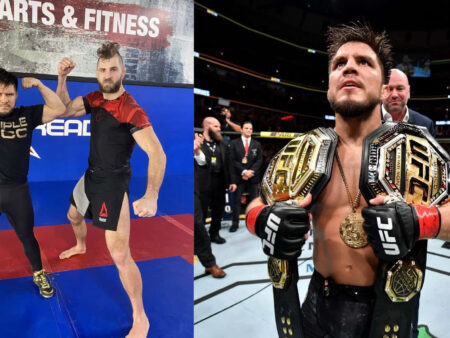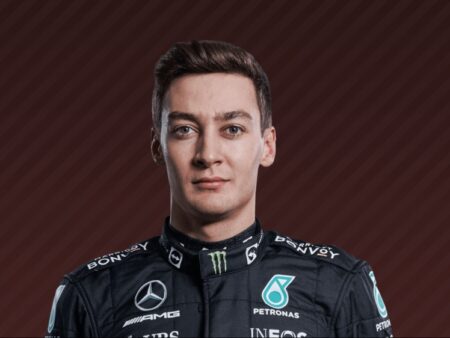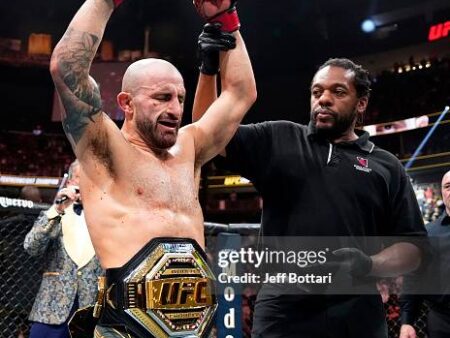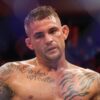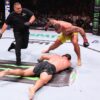When the Boston Celtics, the defending champions, launched 61 three-point attempts on opening night against the New York Knicks, equaling the second-highest number of attempts in a standard NBA game, the impact went beyond just a nationally broadcasted dominant victory.
It ignited a season-long discussion about whether there can be too many three-pointers. This isn`t solely a Boston issue. After stabilizing at around 35 three-point attempts per game over the previous five years, which already represented a more than 50% increase from a decade prior (22.4 per game), the rate of long-range attempts has climbed to 37.5 so far in the 2024-25 season. Amidst declining national TV ratings early in the season, three-pointers became a readily available explanation.
Currently, league analysis suggests that fans generally view the NBA`s style of play and the frequency of three-pointers positively. No immediate changes are expected.
However, Daryl Morey, president of basketball operations for the Philadelphia 76ers and a key figure in the three-point revolution, stated at this month`s MIT Sloan Sports Analytics Conference that `we have reached a point where [the three-pointer] is starting to negatively impact the game.`
Let`s examine what the data reveals about the abundance of three-pointers, Morey`s argument that they are excessively valuable, and what fans truly think about the current state of basketball.
Celtics Lead the Charge — and the Conversation
A year ago, it wasn`t entirely clear if attempting more three-pointers was definitively the optimal strategy for NBA teams. Teams had already maximized the easy gains from converting catch-and-shoot two-pointers into more valuable three-point attempts. During Morey`s tenure with the Houston Rockets, prioritizing three-pointers was almost like exploiting a loophole.
Between 2004-05 and 2018-19, the team that attempted the most three-pointers in a game won 52% of the time, sufficient to elevate a team three games above a .500 record on its own. Partly due to the Rockets` success, this trend reversed. During the 2023-24 regular season, teams that took more three-pointers won only 48% of the time, marking the fourth instance in five years they had fallen below .500.
However, the trend shifted once more. In the 2024 playoffs, teams attempting more three-pointers had a 51-28 (.646) record, and the top two regular-season teams in three-point attempt rate, Boston and Dallas, met in the Finals, with Boston winning.
Starting with the Celtics` opening night victory — where they tied the NBA record with 29 three-pointers and spent the final five minutes attempting long-range shots to break it — it quickly became evident that three-point attempts would increase.
`It`s intriguing to consider an alternate scenario where that game unfolded differently to see if a single game could have shaped such a significant narrative,` Evan Wasch, NBA executive vice president of strategy and analytics, told ESPN. `But it does appear that it served as a starting point for much of the discussion that persisted in the following months.`
Contributing to the narrative was the NBA`s national TV viewership decline during the first two months of the season. Three NBA doubleheaders competed with the highly-rated World Series between the Los Angeles Dodgers and New York Yankees, including games featuring both the Knicks and Los Angeles Lakers on the same night as the thrilling Game 1.
The lower ratings `created an opportunity for people to focus on their preferred issue — which this season was the volume of three-pointers — and attribute the viewership decrease to the three-point trend or increase, without any evidence to support it,` Wasch stated at a Sloan Sports Analytics Conference panel with Morey. This notion became hard for the NBA to dispel and might have begun to influence fan perception. Wasch`s team discovered through league surveys and social media sentiment analysis that growing dissatisfaction with the number of three-pointers and style of play started to emerge a month into the season.
`That signaled to us that either there`s a delay in this data and fan perception of the game, or some of the perception is being shaped by the ongoing discussion,` Wasch said. Regardless, the increase in three-pointers in NBA games is undeniable. After a brief period suggesting peak three-pointers, they are again on the rise. And Morey believes he understands why.
`It Disrupts the Game`: Is It Time to Adjust the 3-Point Line?
When Morey used the Sloan panel — titled provocatively `Have the Nerds Ruined Basketball?` — to urge the NBA to make changes and reduce three-point attempts, it was akin to Frankenstein requesting authorities to stop his creation. Aside from Stephen Curry, the all-time leader, Morey is most associated with the growth in three-point frequency, having designed the Rockets to pursue long-range attempts to levels only matched by this season`s Celtics.
Starting with their G League affiliate in Rio Grande Valley, which served as a testing ground for the NBA team, Houston eliminated almost all two-point attempts outside the paint while maintaining a fast pace. The Rockets became the first team in league history to attempt more three-pointers than two-pointers, achieving a franchise-record 65 wins in 2017-18. Morey`s association with the Rockets` style was so strong it was dubbed `Moreyball,` a blend of his name and the book that introduced baseball analytics to the public.
To clarify, Morey wasn`t exactly against the current rate of three-pointers. His concern was about game design.
When the three-point line was initially introduced, Morey argued, the significant reward was necessary to encourage players to shoot from further away — or, more accurately, for coaches to allow it despite relatively low success rates.
It wasn`t until 1986-87, the three-pointer`s eighth year, that the NBA as a whole shot better than 30% from beyond the arc. It took another six seasons, until 1992-93, for the league to shoot well enough for the average three-pointer to be worth more than a point.
Currently, with players shooting 36% on three-pointers, a typical attempt yields 1.07 points. To match this value with a two-pointer, players would need to shoot 53.5%. This is why Morey discourages his team`s players from taking two-pointers outside the paint, where the league collectively shoots at 42% — only 17% better than three-point accuracy, far less than the 50% difference in value.
`If top players in the league taking open 8-to-15 foot shots is less effective than a heavily contested, off-the-dribble three-pointer, that`s detrimental to the game,` Morey said, `and I believe it`s the league office`s responsibility to investigate this because teams will naturally optimize for what works.`
For the most part, the volume of three-pointers isn`t a primary concern among league executives. They are more focused on building the best possible team than on ensuring the most entertaining product on the court.
`I don`t blame the teams or analysts because their job is simply to win,` Morey said, `but to me, the core issue is that [the three-pointer] was added long ago and is 50% more valuable than other shots. That`s simply too much. It fundamentally disrupts the game.`
Providing the NBA`s viewpoint on the Sloan panel, Wasch countered that game design is only relevant to the extent it creates an enjoyable product for fans. And the NBA continues to find that fan sentiment towards long-range shooting is more positive than negative.
Too Many 3s? Not a Problem for the NBA — Yet
When asked about the three-point issue, NBA commissioner Adam Silver has acknowledged the possibility of adjustments to alter the style of play.
`Historically, we`ve occasionally moved the three-point line,` Silver said at the NBA Cup final in Las Vegas last December. `I don`t believe that`s the solution here because, based on our analysis of both the game and data, it might not necessarily lead to more midrange jumpers, if that`s desired, but rather more congestion near the basket.`
He added: `I watch as many games as you all do, and if anything, it`s not so much a three-point problem. But that to some viewers, some offenses are starting to seem repetitive, and teams are imitating each other. I think that`s something we should be mindful of.`
By the All-Star Game in February, Silver expressed a somewhat more optimistic view of the current state of NBA basketball.
`We are closely monitoring it,` he said. `I`m never going to say there`s no room for improvement. We`ll continue to examine and study it, but I`m pleased with the game`s current state.`
Overall, Wasch`s summary of the NBA`s fan research findings was quite similar.
`Generally, it`s quite positive,` he said in response to Morey`s assessment. `Fans have embraced the three-point revolution. They enjoy pace and spacing, the speed and athleticism of the players, and shots around the basket. There are many positive trends.`
`The question is whether we are now going too far and need to slightly reduce it to win back fans who might be disillusioned by what they`re seeing, but I certainly don`t believe there`s a fundamental issue with the game`s design because the crucial factor is the product we offer to the fans.`
League surveys indicate younger fans are more favorable towards the current style of play and volume of three-pointers than older fans, although Wasch noted the difference wasn`t statistically significant. However, the tone of discussions doesn`t always reflect the statistical reality.
At the Sloan conference, Celtics vice president of basketball operations Mike Zarren voiced frustration with the idea that all teams play the same because they all utilize three-pointers more than in the past. (This season`s team with the fewest three-point attempts, the Denver Nuggets, would have led the NBA as recently as 2013-14.)
`The media narrative that all teams are adopting a uniform style of play and just launching threes, I believe, is inaccurate,` Zarren said. `Most of the discussion isn`t about Daryl`s game design argument… It`s, `Everyone must play the same way, just taking threes,` and that`s not what`s happening in the NBA.`
Could We See Even More 3s?
Wasch mentioned his team studied the variation in play styles among teams and found no significant difference in diversity compared to past seasons. Similarly, the difference in three-point attempt rates between Boston and Denver this season is as large as the average gap since 1996-97. It`s the average rate, not the distribution, that has shifted.
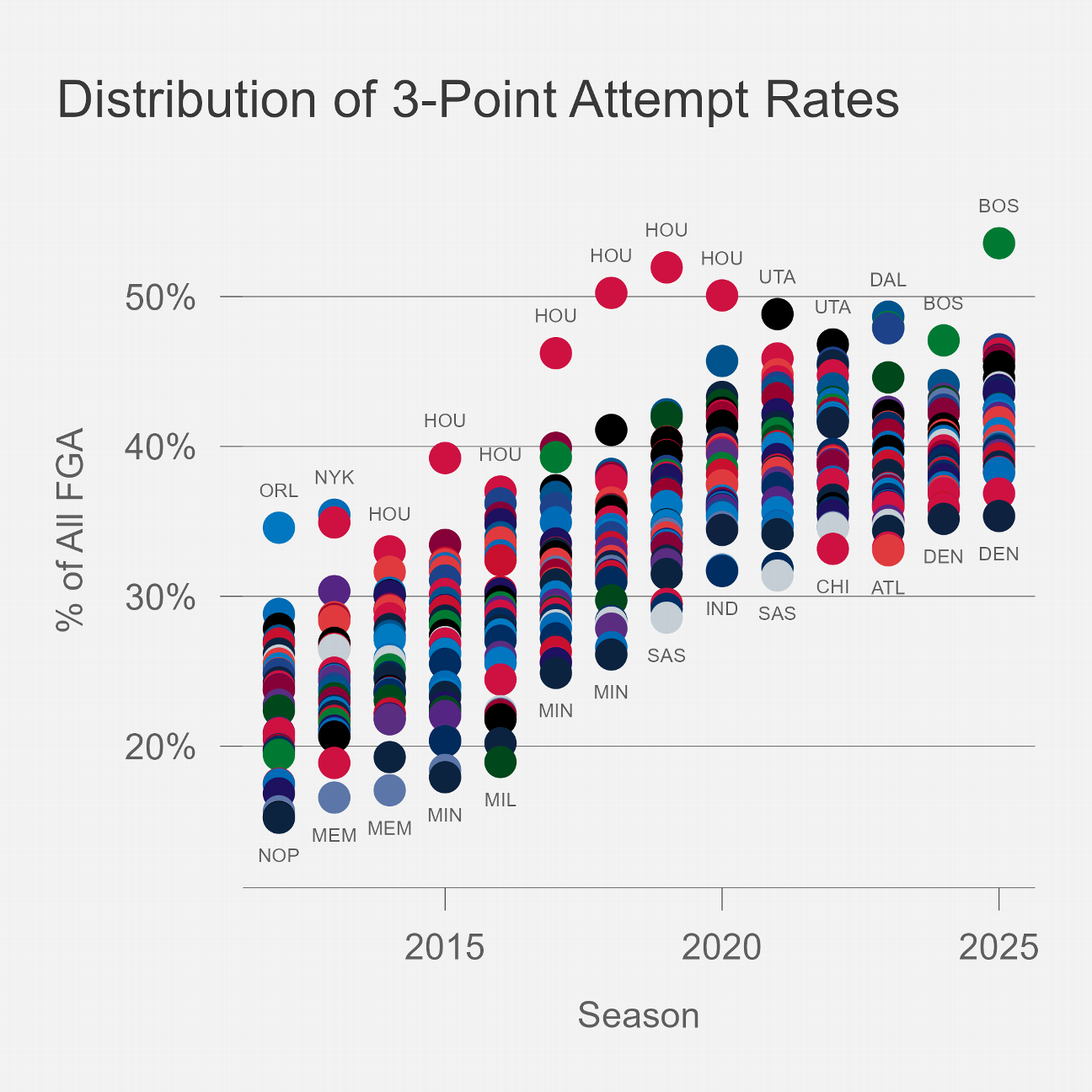
Interestingly, the Celtics have been gradually reducing their three-point attempts relative to the rest of the league. In the first 25 games of the season, Boston averaged 51.3 three-point attempts, accounting for 56% of their field goal attempts. Since then, their average has dropped to 46.5 three-pointers per game, or 52% of all shots.
Nevertheless, similar to the Morey-era Rockets, the Celtics` playoff performance as the likely No. 2 seed in the Eastern Conference will serve as a test of whether there are too many three-pointers — even if they are defeated by the Cleveland Cavaliers, who rank fifth in three-point attempt rate.
Conversely, a deep playoff run by the Nuggets, who are third in offensive rating, might serve as a valuable reminder that there is more than one effective offensive approach.
In any case, we are likely to see even more three-pointers before we see fewer. Younger players have been a significant factor in this season`s increase in long-distance attempts, especially off the dribble. Consider Victor Wembanyama, who attempted almost nine three-pointers per game in his second NBA season — more than Ray Allen, a former all-time three-point leader, averaged in any season of his Hall of Fame career.
Eventually, the NBA will run out of long two-pointers to convert into three-pointers. The idea that players are encouraged to decline layups and dunks for three-pointers is a common misconception about the analytics-driven increase in three-point rates. The proportion of shots in the paint has remained largely consistent in the 12 seasons for which we have Second Spectrum camera-tracking data, with slightly higher rates in the last three seasons.
Despite the popular notion that defenses will become so focused on defending the three-point line that midrange shots will become relatively more valuable, the only proven method other leagues have found to decrease three-point rates is to move the line further back.
As recently as 2018-19, NCAA Division I men`s basketball games had a higher percentage of three-pointers relative to all shots than NBA games, but the following season, the line was moved back to the FIBA distance (a maximum of 22 feet, 1.75 inches, compared to the NBA`s 23 feet, 9 inches maximum). The NCAA saw three-pointers decrease from 39% of shots to 37.5%, and the professional men`s game now significantly exceeds top college games in long-distance attempts.
There might come a point when three-point attempts constitute half of all shots league-wide. For now, three-point rates do not appear to be a problem for the NBA.
`When the data is clear, we take action,` Wasch said. `We are not ignoring the situation. On this issue, we are saying that there may be room for adjustments, but we are not at a point where drastic measures are needed, nor is there a definitive consensus among stakeholders that any action is necessary at all.`
